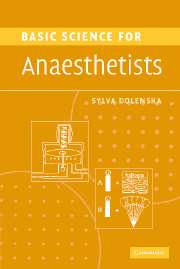Book contents
- Frontmatter
- Contents
- List of abbreviations and symbols
- List of figure captions
- Forewords
- Preface
- Preface to the second edition
- Part 1 Physics, mathematics, statistics, anaesthetic apparatus
- 1 Gas compression, relationship of volume, pressure and temperature
- 2 Real gas compression
- 3 Flow and resistance
- 4 Heat, vaporization and humidification
- 5 Simple mechanics 1: mass, force, pressure
- 6 Simple mechanics 2: work and power
- 7 Mathematical concepts
- 8 Exponentials 1: the curves
- 9 Exponentials 2: properties of exponential decay curve
- 10 Descriptive statistics
- 11 Presentation of data
- 12 Receiver operating characteristic curve
- 13 Gas supply and pressure
- 14 The circle system
- 15 The Mapleson A (Magill) breathing system
- 16 T-pieces
- 17 Lung filling with automatic lung ventilators
- Part 2 Clinical measurement
- Part 3a Physiology: the cardiovascular system
- Part 3b Physiology: the respiratory system
- Part 4 Pharmacology
- Further Reading
- Index
11 - Presentation of data
from Part 1 - Physics, mathematics, statistics, anaesthetic apparatus
Published online by Cambridge University Press: 13 August 2009
- Frontmatter
- Contents
- List of abbreviations and symbols
- List of figure captions
- Forewords
- Preface
- Preface to the second edition
- Part 1 Physics, mathematics, statistics, anaesthetic apparatus
- 1 Gas compression, relationship of volume, pressure and temperature
- 2 Real gas compression
- 3 Flow and resistance
- 4 Heat, vaporization and humidification
- 5 Simple mechanics 1: mass, force, pressure
- 6 Simple mechanics 2: work and power
- 7 Mathematical concepts
- 8 Exponentials 1: the curves
- 9 Exponentials 2: properties of exponential decay curve
- 10 Descriptive statistics
- 11 Presentation of data
- 12 Receiver operating characteristic curve
- 13 Gas supply and pressure
- 14 The circle system
- 15 The Mapleson A (Magill) breathing system
- 16 T-pieces
- 17 Lung filling with automatic lung ventilators
- Part 2 Clinical measurement
- Part 3a Physiology: the cardiovascular system
- Part 3b Physiology: the respiratory system
- Part 4 Pharmacology
- Further Reading
- Index
Summary
The chapter on mathematical concepts deals with graphs as illustrations of relationships between variables. The chapter on descriptive statistics introduces statistical terms.
Diagrams
Diagrams are used to illustrate statistical data (see the chapter on descriptive statistics for explanation of terms).
The pie diagram is the simplest form. It is often used to illustrate data collected from audit. It is useful if there are several categories (portions) of a whole, for instance age groups, different surgical specialties, items of expenditure in budget, etc. The pie diagram gives an immediate idea of how the whole is divided up. Figure 36 shows all patients who experienced nausea after surgery according to the type of operation.
The histogram is best used to show counts – integer numbers of patients, objects or days. Bands or columns are used for the illustration; although each number has only one dimension, plotted against the y-axis, the second dimension – the width of the band – makes the visual distinction between groups easier and distinguishes a histogram from a line graph. Figure 37 shows the comparison of the incidence of postoperative nausea among men and women. Measurements of continuously variable data are best represented by scatter diagram (see below) although the histogram is often used in this situation.
The frequency histogram illustrates the distribution of different values of a measured variable in a certain sample or population. Figure 38 shows the distribution of hypothetical laboratory measurements of fasting blood glucose concentration in all employees of a hospital.
- Type
- Chapter
- Information
- Basic Science for Anaesthetists , pp. 44 - 47Publisher: Cambridge University PressPrint publication year: 2006



